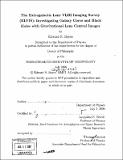The Extragalactic Lens VLBI Imaging Survey (ELVIS) : investigating galaxy cores and black holes with gravitational lens central images
Author(s)
Boyce, Edward R
DownloadFull printable version (8.271Mb)
Alternative title
ELVIS : investigating galaxy cores and black holes with gravitational lens central images
Other Contributors
Massachusetts Institute of Technology. Dept. of Physics.
Advisor
Jacqueline N. Hewitt.
Terms of use
Metadata
Show full item recordAbstract
This thesis describes the Extragalactic Lens VLBI Imaging Survey (ELVIS), a search for central images in gravitational lenses. We present the first four ELVIS targets, for which we have radio VLBI observations with resolutions of a few milli-arcseconds and sensitivities of 15 - 38 Jy. For PMN J1838-3427, CLASS B0739+366 and CLASS B0445+123 we have not detected any central images, but have set stringent upper limits on their flux densities. For CLASS B2319+051 we have made a tentative detection of a third radio source, which may be either a central image or radio emission from the lens galaxy. Using the upper limits on the central image flux densities, we gain new information about the matter distributions in the lens galaxies of these systems. We fit a broken power law model for the matter profile, and constrain the allowed break radii and inner index of this model. To demagnify the central images to the observed level the matter profiles must be slightly shallower than or steeper than isothermal, which is consistent with previous studies of early type galaxy profiles. The presence of a super-massive black hole weakens the constraints somewhat, but the profiles are still close to isothermal. (cont.) Relative to previous work, we reduce the maximum sizes of shallow cores by factors of 2 to 3, and raise the indices of ... central cusps by y = 0.05 - 0.35. If we take the source in B2319+051 to be a central image, then we select a narrow band of allowed break radii and inner indices, finding that a constant density core has size 150-380 pc, and a pure power law has index y = 1.5 - 1.67. Our constraints still allow sufficiently shallow profiles that some super-massive black holes may form central image pairs rather than eliminating the central image, and these image pairs may be detected with future instruments.
Description
Thesis (Ph. D.)--Massachusetts Institute of Technology, Dept. of Physics, September 2006. "July 2006." Includes bibliographical references (p. 80-84).
Date issued
2006Department
Massachusetts Institute of Technology. Department of PhysicsPublisher
Massachusetts Institute of Technology
Keywords
Physics.